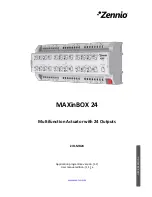
Configuring Spanning Tree Protocol
D-Link
Unified Wired and Wireless Access System
Oct. 2015
Page 251
D-Link UWS User Manual
Port Forwarding State
Indicates the current state of a port. If enabled, the port state determines
what forwarding action is taken on traffic. Possible port states are:
•
Disabled:
is currently disabled on the port. The port forwards traffic while
learning MAC addresses.
•
Blocking:
The port is currently blocked and cannot be used to forward
traffic or learn MAC addresses.
•
Listening:
The port is currently in the listening mode. The port cannot
forward traffic nor can it learn MAC addresses.
•
Learning:
The port is currently in the learning mode. The port cannot
forward traffic, however, it can learn new MAC addresses.
•
Forwarding:
The port is currently in the forwarding mode. The port can
forward traffic and learn new MAC addresses.
Port Role
Each MST Bridge Port that is enabled is assigned a Port Role for each spanning
tree. The port role will be one of the following values: Root Port, Designated
Port, Alternate Port, Backup Port, Master Port or Disabled Port.
Designated Root
Root Bridge for the CST. It is made up using the bridge priority and the base
MAC address of the bridge.
Designated Cost
Displays cost of the port participating in the topology. Ports with a lower cost
are less likely to be blocked if detects loops.
Designated Bridge
Bridge Identifier of the bridge with the Designated Port. It is made up using the
bridge priority and the base MAC address of the bridge.
Designated Port
Port Identifier on the Designated Bridge that offers the lowest cost to the LAN.
It is made up from the port priority and the interface number of the port.
Topology Change
Acknowledge
Identifies whether the next BPDU to be transmitted for this port would have
the topology change acknowledgement flag set. It is either "True" or "False".
Auto Edge
Configuring the auto edge mode of a port allows the port to become an edge
port if it does not see BPDUs for some duration. The possible values are Enable
or Disable.
Edge Port
Indicates whether the port is enabled as an edge port.
Point-to-point MAC
Derived value of the point-to-point status.
Root Guard
Configuring the root guard mode sets a port to discard any superior
information received by the port and thus protect against root of the device
from changing. The port gets put into discarding state and does not forward
any packets.The possible values are Enable or Disable.
Loop Guard
Configuring the loop guard mode prevents a port from erroneously
transitioning from blocking state to forwarding when the port stops receiving
BPDUs. The port is marked as being in loop-inconsistent state. In this state, the
port does not forward packets. The possible values are Enable or Disable.
TCN Guard
Configuring the TCN guard for a port restricts the port from propagating any
topology change information received through that port.The possible values
are Enable or Disable.
CST Regional Root
Shows the priority and base MAC address of the CST Regional Root.
CST Path Cost
Shows the path Cost to the CST tree Regional Root.
Loop Inconsistent State
Identifies whether the port is currently in a loop inconsistent state. If the port
is in a loop inconsistent state, it does not forward packets.
Table 135: Spanning Tree CST Port Configuration/Status Fields (Cont.)
Field
Description
Summary of Contents for DWL-8600AP
Page 754: ......
















































